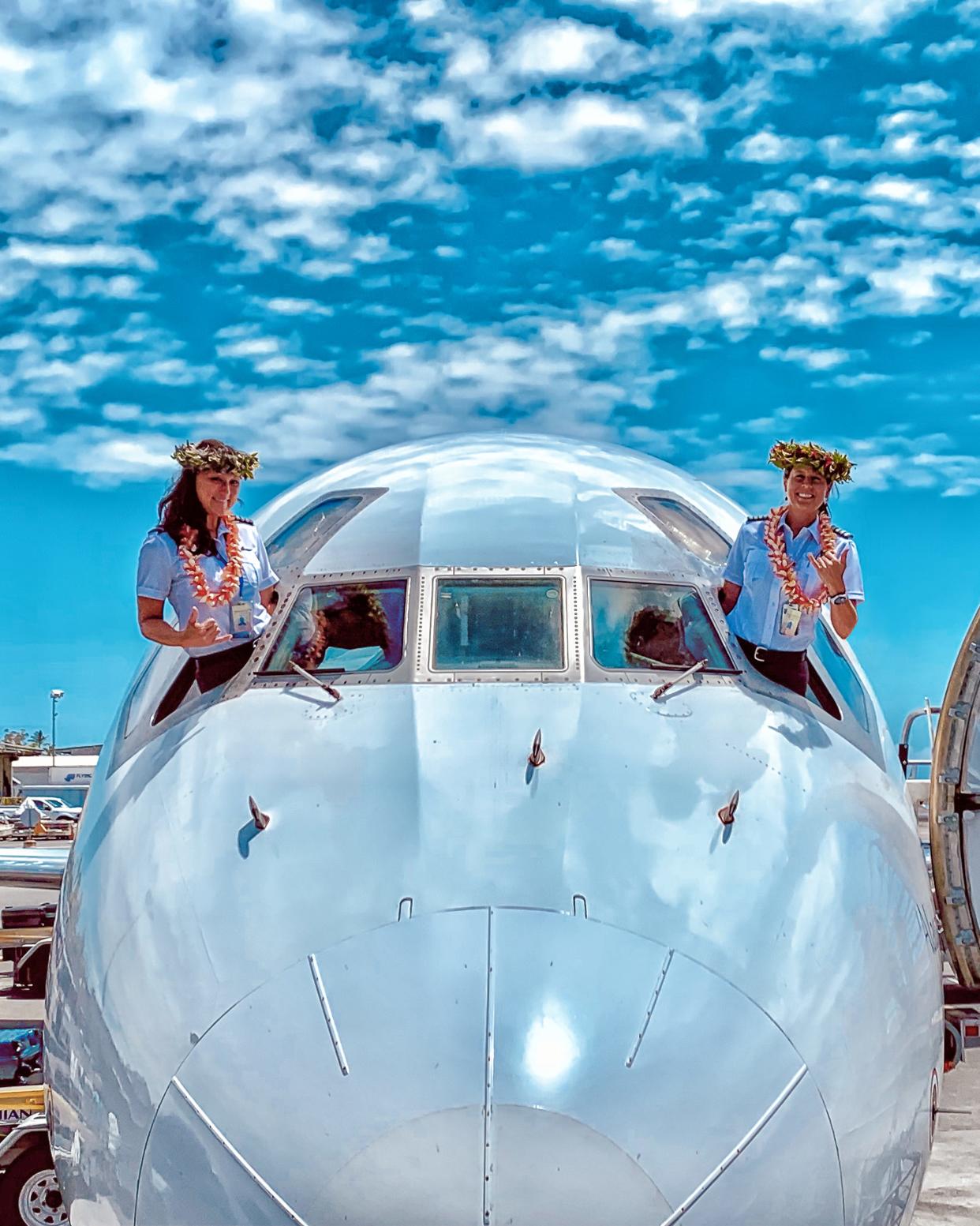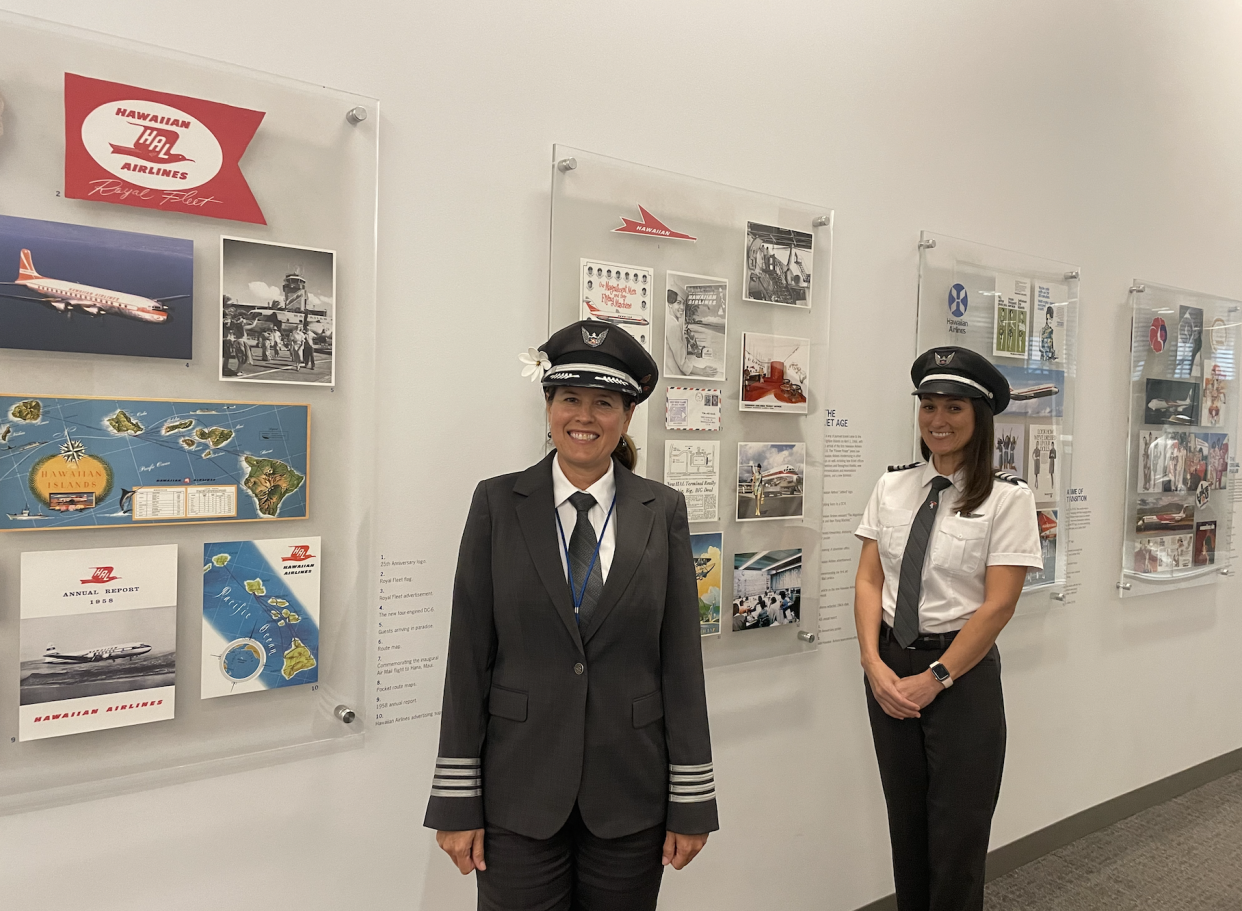You can't be what you can't see: 2 female pilots share their experience being among the few
Hawaiian Airlines pilot Mimi Mycynek has been fascinated by planes since she was a little girl. "I can remember being on a 747 and the feeling was better than Christmas for me," she said of the recurring trips to her mother's native Japan.
Mycynek, who was born and raised in Oahu, wanted to work on a plane but didn't know in what capacity. "I never thought I was smart enough to be a pilot or if that was even possible," she said.
When Mycynek was 20, she took an intro flight and that gave her the confidence to keep pursuing flying as a career. She's been flying for 20 years since and in April, she'll hit her seven-year anniversary with Hawaiian Airlines.
For Melissa "Missy" Maii Mowat,however, the the journey to the cockpit had its share of turbulence.
Mowat, also an Oahu native, studied marketing in college and then worked odd jobs like bartending. She found herself as a customer service agent at Island Air, a now-defunct airline carrier based out of Hawaii, and moved around until she was a dispatcher. That was when a pilot suggested she take an intro flight.
"I never thought about it until the position I was in, briefing the pilots, and somebody said, hey, you should try it," Mowat said.
She was "hooked instantly." She flew around the west side of Oahu and fell in love with the peacefulness and feeling "like a bird." Mowat has been flying for Hawaiian Airlines for 23 years now.
Mycynek and Mowat are two of the few female commercial airline pilots in the nation.
In 2020, less than 5% of airline pilots identified as female, according to the Federal Aviation Association's Breaking Barriers for Women in Aviation: Flight Plan for the Future report. The stats are even lower for women of color likeMycynek and Mowat, who make up only 1% of the pilot ranks. Mowat, who is an airline captain, is part of the mere 3.6% of airline captains in the U.S. who are women.

Hawaiian Airlines has the highest percentage of female pilots out of all U.S.-based carriers, with 9.5%, compared to an industry average of between 5.5% and 8.5%. The next U.S.-based airline carrier with the most female pilots is United with 7.7%, according to the International Society of Women Airline Pilots (ISA+21).
Leading the pack when it comes to gender diversity isn't a totally new concept to the destination carrier based out of Hawaii. On March 6, 1979, the airline made history for having the first all-female crew to fly a scheduled flight in the nation, a brief flight from Honolulu to Molokai.
One more taste of Hawaii: Hawaiian Airlines first class menu highlights award-winning chef
Breaking barriers: First mother-daughter pilot duo take flight, make history at Hawaiian Airlines
Getting more women into the cockpit
The first all-female crew serves as a reminder that there's a largely untapped demographic as airlines try to combat the current pilot shortage: women.
The issue isn't that women don't want to be pilots but rather a lack of visibility, mentorship and exposure in a historically male-dominated industry, according to ISA+21.
"Representation is absolutely key in recruiting more women and minorities into the flight deck," Erin Jackson, a first officer and communications director for ISA+21, said to USA TODAY. "A phrase we use often is 'you can't be what you can't see.' It's not that young women don't want to be pilots, it's just that they don't even think of becoming pilots because they don't see them."

In a 2020 survey of women in aviation by the University of Nebraska Omaha Aviation Institute, over half said that "exposure to aviation as a child positively influenced their decision to pursue aviation careers."
Change has unfortunately been incredibly slow. While more women are becoming commercial airline pilots, the representation of women in the industry has remained pretty stagnant, only improving by about 1% a decade, the FAA report said.
Female pilots face additional hurdles than their male counterparts
Hostility and discrimination from gender biases and sexual harassment are also hurdles for women or push them to leave the industry.
"There's still an era where people are still very close-minded about certain things," Mowat said.
She said she's never faced discrimination from her crew and colleagues, but she and Mycynek have had passengers say sexist things to them – after they landed the plane and were wearing their pilot uniform.
"This older man, he's walking down (the aisle as I'm saying goodbye to the passengers) and goes, if I knew a female was flying this plane, I wouldn't have gotten on the airplane," Mowat said. "And I was biting my tongue. There's just a lot of ignorance."
However, there's no denying that more targeted efforts are being put into recruiting and retaining women recently.
The monetary issue
"There is a ton of support out there, like scholarships and organizations like Women in Aviation International," Mycynek said. There are also groups for diverse pilots, such as Sisters of the Skies, which focuses on supporting Black female pilots.
Targeted scholarships are important since flight training comes at a high cost of nearly $100,000.
Sen. Tammy Baldwin, D-Wis., recently proposed legislation that would increase the financial assistance available to flight school students, including expanding the amount of federal loans they qualified for.
Wings of change: Long before United, Black pilots flew freely in American skies
Blue Angel history: Blue Angels name first woman to serve as demonstration pilot
"It needs to be a concerted and partnered effort on the part of the airlines, the pilot unions, and organizations like ours to get the message out. And I think it needs to start before the collegiate level," Jackson said.
Mowat will soon present at career day at her alma mater, Kaiser High School in East Honolulu. ISA+21 members are always speaking at primary and high schools. To introduce more kids to flying, Hawaiian sponsored an exhibit with a flight simulator at the Children's Discovery Center in Honolulu and has a Career Ambassador Program.
There are also the little moments as a pilot that can make a big impact, like when passengers tell Mowat how their granddaughters want to become pilots when they grow up.
Other airlines, such as United, which is the only U.S. airline to have its own flight school that opened in 2022, has pledged to have more of its pilot trainees be women and people of color, also offering scholarships.
Last year, Delta Air Lines announced a partnership program with Historically Black Colleges and Universities to help recruit more Black pilots.
Making it work for you
Many parents may find the schedule of a pilot, where you are away for days or nights at a time, to be challenging. Gender norms still place more childcare pressure on the mother, although times are changing and more women are in demanding STEM jobs now more than ever.
"We're mothers and to care for your child, you have to be away, and I think that's a tough part," Mycynek said. "It's not easy for sure. We're both single moms."
There's also flexibility to a pilot's nontraditional work schedule that can be an advantage. At Hawaiian Airlines, Mowat said, there's a unique structure to managing a work-life balance. As a destination carrier, all flights return to Hawaii.
Flying inter-island – or the short flights between neighbor islands in Hawaii – means the pilot returns home every day, which Mowat did for almost 20 years.
Is it expensive to island hop in Hawaii?: Here's how to save money and fly between islands.
"I could go to every single one of (my daughter's) events she had in elementary," Mowat said. "I could create a schedule for myself, it wasn't a Monday through Friday, if you want to work a weekend day you can so you're home during the week."
With these neighbor island flights, you could fly all morning or only the evenings, and be home at the end of the night, she said. (The inter-island flights depart nearly every hour until around 8 or 9 p.m.)
Mycynek said the long-haul flight from Honolulu to Korea works for her family. "It's a three-day trip so if I leave on Friday, I'm back Sunday," and she can spend the workweek with her 15-year-old daughter, who also wants to be a pilot when she's older.
With her seniority, Mycynek now gets holidays off to spend more time with her family.
There's also the obvious perk: traveling. Both pilots love taking their family on trips using their flight benefits.
The big and little moments
Mowat will never forget the first time she flew a jet. She had just finished her flight training and was already hired by Hawaiian when all that was left was her landings and approaches in an empty DC9. To her, it felt like driving "a Porsche versus a run-down jalopy." For now, Mowat eagerly waits to fly the Dreamliner.
"Getting paid to fly a jet was my dream," Mycynek echoed. "Being at Hawaiian, even moreso, that was like the frosting on the cake."
For many people who grow up in Hawaii, Hawaiian Airlines is iconically known as "the local air carrier," Mowat said.
"You're literally flying family and friends," Mycynek added.
Mowat loves when she sees kids on the plane and always asks if they want to go into the cockpit to sit in the chair and play with some of the buttons (the ones that don't do anything, she assured). These interactions encourage the next generation of women pilots.
"That's why I bring the kids in, any kids, like the girls, to say, hey, you can do this too you know."
Kathleen Wong is a travel reporter for USA TODAY based in Hawaii. You can reach her at kwong@usatoday.com
This article originally appeared on USA TODAY: What it's like to be a female pilot for Hawaiian Airlines